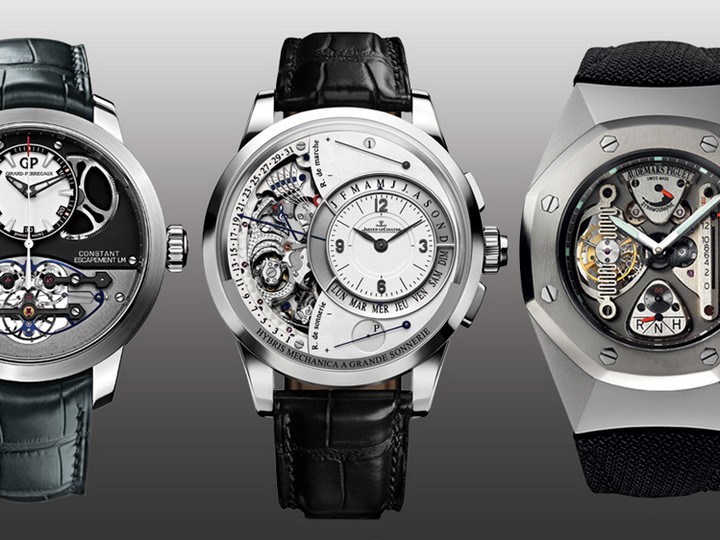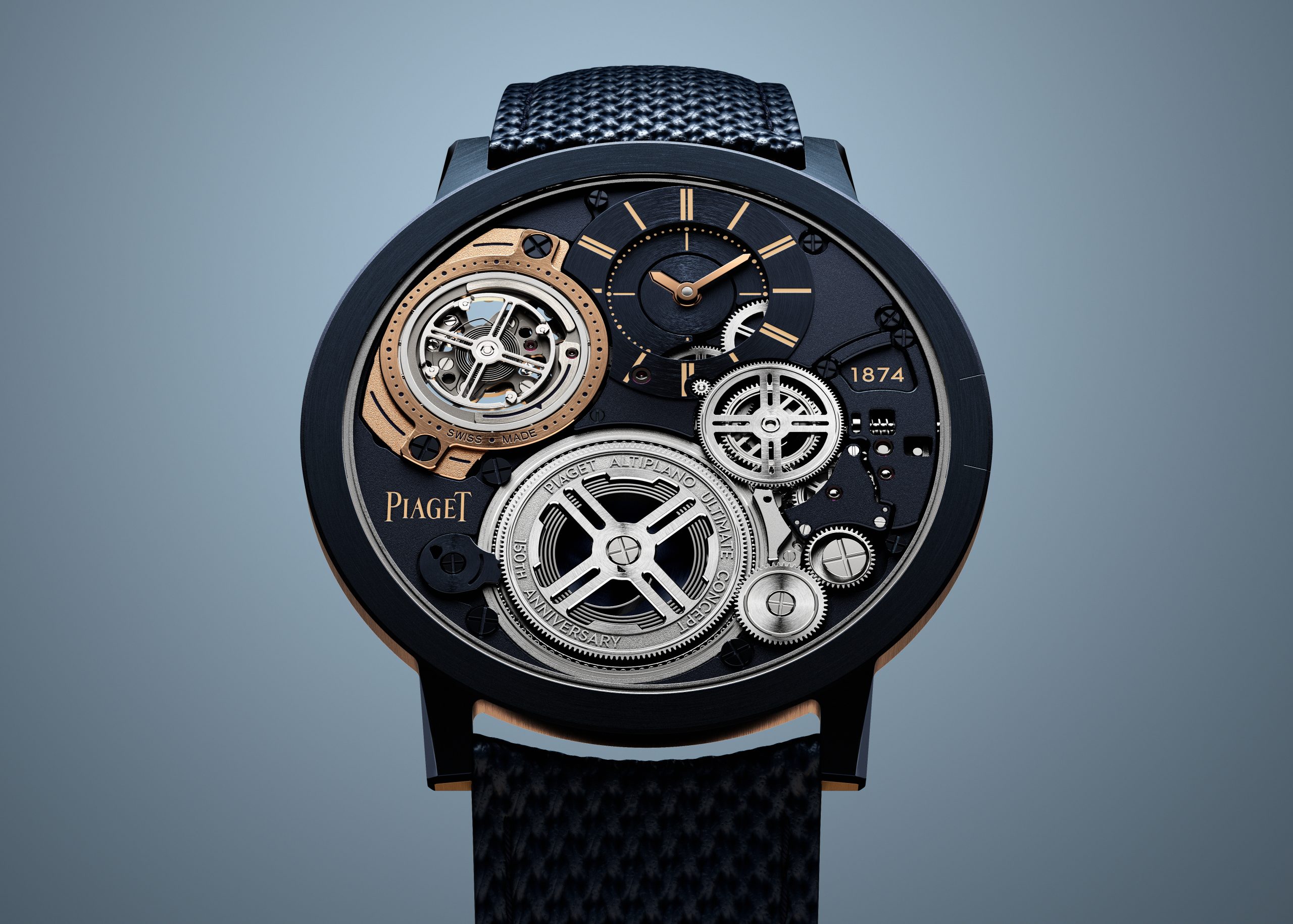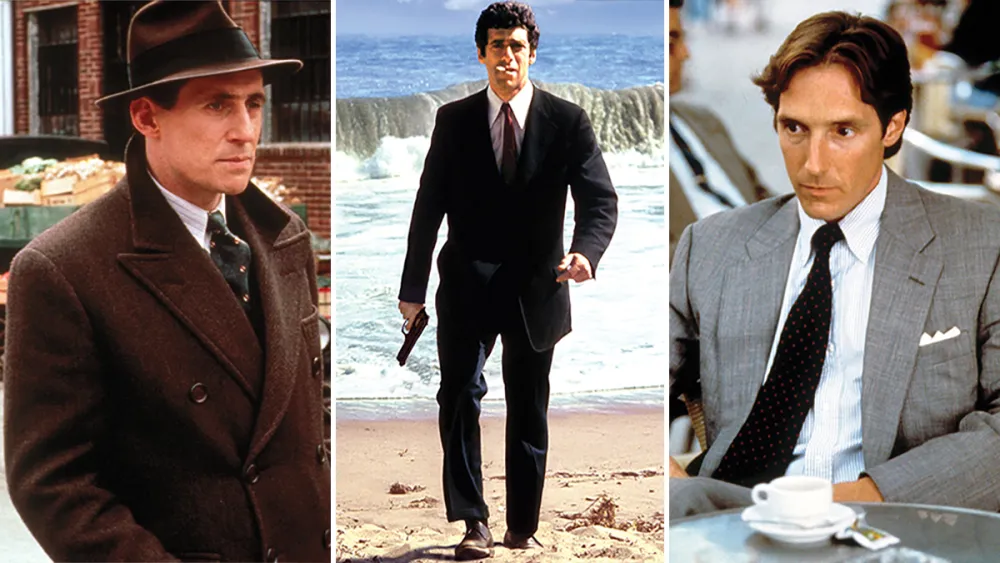
Twelve watches that rewrote the rules of horology
During this millennium, 12 key innovations have thus far made their mark on the art and science of keeping time.
Related articles
In the annals of modern watchmaking, the drive for innovation has been a constant. From the first tourbillon by Abraham-Louis Breguet in 1801 to the debut of carbon and silicon components more recently, watch brands have jockeyed for position in the field. Since 2001, the Grand Prix d’Horlogerie de Genève’s Aiguille d’Or prize has been bestowed annually upon pioneers for forging new ground. During this millennium, 12 key innovations have thus far made their mark on the art and science of keeping time.
2003: Franck Muller Revolution 2 Tourbillon

Innovation: The world’s first multi-axis tourbillon wristwatch
Genesis: Franck Muller’s team leveraged modern manufacturing to effectively miniaturize the biaxial tourbillon carriage clocks developed by Anthony Randall and Richard Good in the late 1970s. ($US800,000 ($A992,850))
2001: Ulysse Nardin Freak

Innovation: A new escapement design
Genesis: The Freak’s movement parts could not be manufactured with the materials that were considered standard at that time (aluminum, steel, and brass), prompting Ulysse Nardin to begin experiments with silicon. That and a new front-and-center escapement designed by Ludwig Oechslin introduced a vastly different way of displaying time. (from $US75,000 ($A93,100))
2002: Audemars Piguet Royal Oak Concept Watch

Innovation: A sprung tourbillon bridge and dynamograph
Genesis: The tourbillon bridge acts as a functional spring, protecting the delicate movement. The function selector at 6 o’clock enables the disconnection of the winding stem from the tourbillon, protecting the mechanism from potential damage caused by external shocks to the crown.
2006: Patek Philippe Ref. 5350R Advanced Research

Innovation: The Spiromax hairspring
Genesis: To reduce wear, magnetism, and the need for lubrication, the Spiromax hairspring was created using Silinvar, a silica-based material developed by Patek with Rolex and the Swatch Group. Patek’s first applications came with its Silinvar escape wheel, the success of which led to the creation of a nonmetal hairspring.
2009 Jaeger-LeCoultre Hybris Mechanica à Grande Sonnerie

Innovation: The longest and most complex chiming of a wristwatch (also equipped with a perpetual calendar and flying tourbillon)
Genesis: A combination of new gong shapes, new alloys, and a reworked movement architecture based on the design practices of the Duomètre line — which relied on one gear train to regulate timekeeping and another the complications — led to the development of the Grande Sonnerie. (Price upon request)
2010: De Bethune DB28

Innovation: Floating-lug case design
Genesis: After the successful fabrication of a silicon-and-palladium balance wheel as well as several other innovations used in its Dream Watch 1, De Bethune turned its attention to case design with the DB28. Pivoting from a central point on either side of the watch case, the DB28’s free-floating lugs adapt to any wrist motions and trim excess weight from the case. (Titanium: $US100,000 ($A124,100))
2012: HYT H1 Black

Innovation: Hydromechanical wristwatch
Genesis: After launching the micro-fluidic technology firm Preciflex (and locking down a few key patents for fluid distribution), the founders of HYT turned to the famed Renaud et Papi to create a caliber that could be mated to their hydraulic system. This innovative marriage of mechanics and fluids resulted in the ideal “water watch.” ($US59,000 ($A73,200))
2012: Richard Mille RM 056 Tourbillon Chronograph Sapphire Felipe Massa

Innovation: The first production sapphire watch case
Genesis: Although its hardness makes it difficult to cut and machine, sapphire crystal proved the ideal material to showcase Richard Mille’s technical prowess. After roughly 1,000 hours of machining, forming, and polishing sapphire case components, this extraordinary timepiece emerged.
2013: Jaquet Droz Charming Bird

Innovation: Miniaturized, chirping automaton in a wristwatch
Genesis: Saluting its automaton clocks of the 18th and 19th centuries, Jaquet Droz created what looks like a wrist-worn version of a cuckoo clock. Carbon pistons and compressed air stored in sapphire tubes work like a music-box mechanism to create chirps and control the hand-painted bird’s gestures. ($US399,000 ($A48,400))
2013: Girard-Perregaux Constant Escapement L.M.

Innovation: A silicon-blade constant-escapement mechanism that maintains accurate and equal amplitude over a 6-day power reserve
Genesis: During his stint at Rolex, the escapement’s inventor, Nicolas Déhon, built 20 prototypes using a Nivarox alloy that was unequal to the task. At Girard-Perregaux, he realized that silicon offered the ideal solution. ($US123,500 ($A153,250))
2013: Urwerk EMC

Innovation: Electronic monitoring and user adjustment of performance
Genesis: Urwerk engineered a balance wheel capable of being read by an optical sensor and a compact, case-housed generator that powered a small processor, enabling the EMC to measure and report the difference between the timing rates of the movement and the reference oscillator. Users can adjust the timing screw on the caseback to optimize performance. (From $US120,000 ($A148,900))
2017: A. Lange & Söhne Tourbograph Perpetual Pour Le Mérite

Innovation: Combining five particular complications into a single masterpiece: a tourbillon, fusee chain, a chronograph with a split-seconds function, and a perpetual calendar — a feat deemed impossible by many
Genesis: Starting from an earlier Pour Le Mérite caliber, Lange built the perpetual-calendar mechanism around the tourbillon to conserve space and recessed the tourbillon deeper into the movement, ensuring an optimal and efficient organisation of complications. ($US559,000 ($A693,750)
Subscribe to the Newsletter
Recommended for you
Omega Reveals a New Speedmaster Ahead of the Paris 2024 Olympics
Your first look at the new Speedmaster Chronoscope, designed in the colour theme of the Paris Olympics.
By Josh Bozin
April 26, 2024
Watch of the Week: the Piaget Altiplano Ultimate Concept Tourbillon
The new release claims the throne as the world’s thinnest Tourbillon.
By Josh Bozin
April 19, 2024
You may also like.
You may also like.
8 Fascinating Facts You Didn’t Know About Aston Martin
The British sports car company is most famous as the vehicle of choice for James Bond, but Aston Martin has an interesting history beyond 007.
Aston Martin will forever be associated with James Bond, ever since everyone’s favourite spy took delivery of his signature silver DB5 in the 1964 film Goldfinger. But there’s a lot more to the history of this famed British sports car brand beyond its association with the fictional British Secret Service agent.
Let’s dive into the long and colourful history of Aston Martin.
You may also like.
What Venice’s New Tourist Tax Means for Your Next Trip
The Italian city will now charge visitors an entry fee during peak season.
Visiting the Floating City just got a bit more expensive.
Venice is officially the first metropolis in the world to start implementing a day-trip fee in an effort to help the Italian hot spot combat overtourism during peak season, The Associated Press reported. The new program, which went into effect, requires travellers to cough up roughly €5 (about $AUD8.50) per person before they can explore the city’s canals and historic sites. Back in January, Venice also announced that starting in June, it would cap the size of tourist groups to 25 people and prohibit loudspeakers in the city centre and the islands of Murano, Burano, and Torcello.
“We need to find a new balance between the tourists and residents,’ Simone Venturini, the city’s top tourism official, told AP News. “We need to safeguard the spaces of the residents, of course, and we need to discourage the arrival of day-trippers on some particular days.”
During this trial phase, the fee only applies to the 29 days deemed the busiest—between April 25 and July 14—and tickets will remain valid from 8:30 am to 4 pm. Visitors under 14 years of age will be allowed in free of charge in addition to guests with hotel reservations. However, the latter must apply online beforehand to request an exemption. Day-trippers can also pre-pay for tickets online via the city’s official tourism site or snap them up in person at the Santa Lucia train station.
“With courage and great humility, we are introducing this system because we want to give a future to Venice and leave this heritage of humanity to future generations,” Venice Mayor Luigi Brugnaro said in a statement on X (formerly known as Twitter) regarding the city’s much-talked-about entry fee.
Despite the mayor’s backing, it’s apparent that residents weren’t totally pleased with the program. The regulation led to protests and riots outside of the train station, The Independent reported. “We are against this measure because it will do nothing to stop overtourism,” resident Cristina Romieri told the outlet. “Moreover, it is such a complex regulation with so many exceptions that it will also be difficult to enforce it.”
While Venice is the first city to carry out the new day-tripper fee, several other European locales have introduced or raised tourist taxes to fend off large crowds and boost the local economy. Most recently, Barcelona increased its city-wide tourist tax. Similarly, you’ll have to pay an extra “climate crisis resilience” tax if you plan on visiting Greece that will fund the country’s disaster recovery projects.
You may also like.
Omega Reveals a New Speedmaster Ahead of the Paris 2024 Olympics
Your first look at the new Speedmaster Chronoscope, designed in the colour theme of the Paris Olympics.
The starters are on the blocks, and with less than 100 days to go until the Paris 2024 Olympics, luxury Swiss watchmaker Omega was bound to release something spectacular to mark its bragging rights as the official timekeeper for the Summer Games. Enter the new 43mm Speedmaster Chronoscope, available in new colourways—gold, black, and white—in line with the colour theme of the Olympic Games in Paris this July.
So, what do we get in this nicely-wrapped, Olympics-inspired package? Technically, there are four new podium-worthy iterations of the iconic Speedmaster.

The new versions present handsomely in stainless steel or 18K Moonshine Gold—the brand’s proprietary yellow gold known for its enduring shine. The steel version has an anodised aluminium bezel and a stainless steel bracelet or vintage-inspired perforated leather strap. The Moonshine Gold iteration boasts a ceramic bezel; it will most likely appease Speedy collectors, particularly those with an affinity for Omega’s long-standing role as stewards of the Olympic Games.
Notably, each watch bears an attractive white opaline dial; the background to three dark grey timing scales in a 1940s “snail” design. Of course, this Speedmaster Chronoscope is special in its own right. For the most part, the overall look of the Speedmaster has remained true to its 1957 origins. This Speedmaster, however, adopts Omega’s Chronoscope design from 2021, including the storied tachymeter scale, along with a telemeter, and pulsometer scale—essentially, three different measurements on the wrist.
While the technical nature of this timepiece won’t interest some, others will revel in its theatrics. Turn over each timepiece, and instead of a transparent crystal caseback, there is a stamped medallion featuring a mirror-polished Paris 2024 logo, along with “Paris 2024” and the Olympic Rings—a subtle nod to this year’s games.
Powering this Olympiad offering—and ensuring the greatest level of accuracy—is the Co-Axial Master Chronometer Calibre 9908 and 9909, certified by METAS.

A Speedmaster to commemorate the Olympic Games was as sure a bet as Mondo Deplantis winning gold in the men’s pole vault—especially after Omega revealed its Olympic-edition Seamaster Diver 300m “Paris 2024” last year—but they delivered a great addition to the legacy collection, without gimmickry.
However, the all-gold Speedmaster is 85K at the top end of the scale, which is a lot of money for a watch of this stature. By comparison, the immaculate Speedmaster Moonshine gold with a sun-brushed green PVD “step” dial is 15K cheaper, albeit without the Chronoscope complications.
—
The Omega Speedmaster Chronoscope in stainless steel with a leather strap is priced at $15,725; stainless steel with steel bracelet at $16,275; 18k Moonshine Gold on leather strap $54,325; and 18k Moonshine Gold with matching gold bracelet $85,350, available at Omega boutiques now.
Discover the collection here
You may also like.
Here’s What Goes Into Making Jay-Z’s $1,800 Champagne
We put Armand de Brignac Blanc de Noirs Assemblage No. 4 under the microsope.
In our quest to locate the most exclusive and exciting wines for our readers, we usually ask the question, “How many bottles of this were made?” Often, we get a general response based on an annual average, although many Champagne houses simply respond, “We do not wish to communicate our quantities.” As far as we’re concerned, that’s pretty much like pleading the Fifth on the witness stand; yes, you’re not incriminating yourself, but anyone paying attention knows you’re probably guilty of something. In the case of some Champagne houses, that something is making a whole lot of bottles—millions of them—while creating an illusion of rarity.
We received the exact opposite reply regarding Armand de Brignac Blanc de Noirs Assemblage No. 4. Yasmin Allen, the company’s president and CEO, told us only 7,328 bottles would be released of this Pinot Noir offering. It’s good to know that with a sticker price of around $1,800, it’s highly limited, but it still makes one wonder what’s so exceptional about it.
Known by its nickname, Ace of Spades, for its distinctive and decorative metallic packaging, Armand de Brignac is owned by Louis Vuitton Moët Hennessy and Jay-Z and is produced by Champagne Cattier. Each bottle of Assemblage No. 4 is numbered; a small plate on the back reads “Assemblage Four, [X,XXX]/7,328, Disgorged: 20 April, 2023.” Prior to disgorgement, it spent seven years in the bottle on lees after primary fermentation mostly in stainless steel with a small amount in concrete. That’s the longest of the house’s Champagnes spent on the lees, but Allen says the winemaking team tasted along the way and would have disgorged earlier than planned if they’d felt the time was right.
Chef de cave, Alexandre Cattier, says the wine is sourced from some of the best Premier and Grand Cru Pinot Noir–producing villages in the Champagne region, including Chigny-les-Roses, Verzenay, Rilly-la-Montagne, Verzy, Ludes, Mailly-Champagne, and Ville-sur-Arce in the Aube département. This is considered a multi-vintage expression, using wine from a consecutive trio of vintages—2013, 2014, and 2015—to create an “intense and rich” blend. Seventy percent of the offering is from 2015 (hailed as one of the finest vintages in recent memory), with 15 percent each from the other two years.

This precisely crafted Champagne uses only the tête de cuvée juice, a highly selective extraction process. As Allen points out, “the winemakers solely take the first and freshest portion of the gentle cuvée grape press,” which assures that the finished wine will be the highest quality. Armand de Brignac used grapes from various sites and three different vintages so the final product would reflect the house signature style. This is the fourth release in a series that began with Assemblage No. 1. “Testing different levels of intensity of aromas with the balance of red and dark fruits has been a guiding principle between the Blanc de Noirs that followed,” Allen explains.
The CEO recommends allowing the Assemblage No. 4 to linger in your glass for a while, telling us, “Your palette will go on a journey, evolving from one incredible aroma to the next as the wine warms in your glass where it will open up to an extraordinary length.” We found it to have a gorgeous bouquet of raspberry and Mission fig with hints of river rock; as it opened, notes of toasted almond and just-baked brioche became noticeable. With striking acidity and a vein of minerality, it has luscious nectarine, passion fruit, candied orange peel, and red plum flavors with touches of beeswax and a whiff of baking spices on the enduring finish. We enjoyed our bottle with a roast chicken rubbed with butter and herbes de Provence and savored the final, extremely rare sip with a bit of Stilton. Unfortunately, the pairing possibilities are not infinite with this release; there are only 7,327 more ways to enjoy yours.
You may also like.
Bill Henson Show Opens at Roslyn Oxley9 Gallery
Dark, grainy and full of shadows Bill Henson’s latest show draws on 35 mm colour film shot in New York City in 1989.
Bill Henson is one of Australia’s best-known contemporary photographers. When a show by this calibre of artist opens here, the art world waits with bated breath to see what he will unveil.
This time, he presents a historically important landscape series that chronicles a time in New York City that no longer exists. It’s a nostalgic trip back in time, a nocturnal odyssey through the frenetic, neon-lit streets of a long-lost America.
Known for his chiaroscuro style, Henson’s cinematic photographs often transform his subject into ambiguous objects of beauty. This time round, the show presents a mysterious walk through the streets of Manhattan, evoking a seedy, yet beautiful vision of the city.


Relying on generative gaps, these landscapes result from Henson mining his archive of negatives and manipulating them to produce a finished print. Sometimes, they are composed by a principle of magnification, with Henson honing in on details, and sometimes, they are created through areas of black being expanded to make the scene more cinematic and foreboding. Like silence in a film or the pause in a pulse, the black suggests the things you can’t see.




Henson’s illustrious career has spanned four decades and was memorably marred by controversy over a series of nude adolescent photographs shown in 2008, which made him front-page news for weeks. This series of portraits made Henson the subject of a police investigation during which no offence was found.
In recent years, Henson has been a sharp critic of cancel culture, encouraging artists to contribute something that will have lasting value and add to the conversation, rather than tearing down the past.

His work deals with the liminal space between the mystical and the real, the seen and unseen, the boundary between youth and adulthood.
His famous Paris Opera Project, 1990-91, pictured above, is similarly intense as the current show, dwelling on the border between the painterly and the cinematic.
Bill Henson’s ‘The Liquid Night’ runs until 11 May 2024 at Roslyn Oxley9 Gallery.
Roslyn Oxley9 Gallery, 8 Soudan Ln, Paddington NSW; roslynoxley9.com.au


























